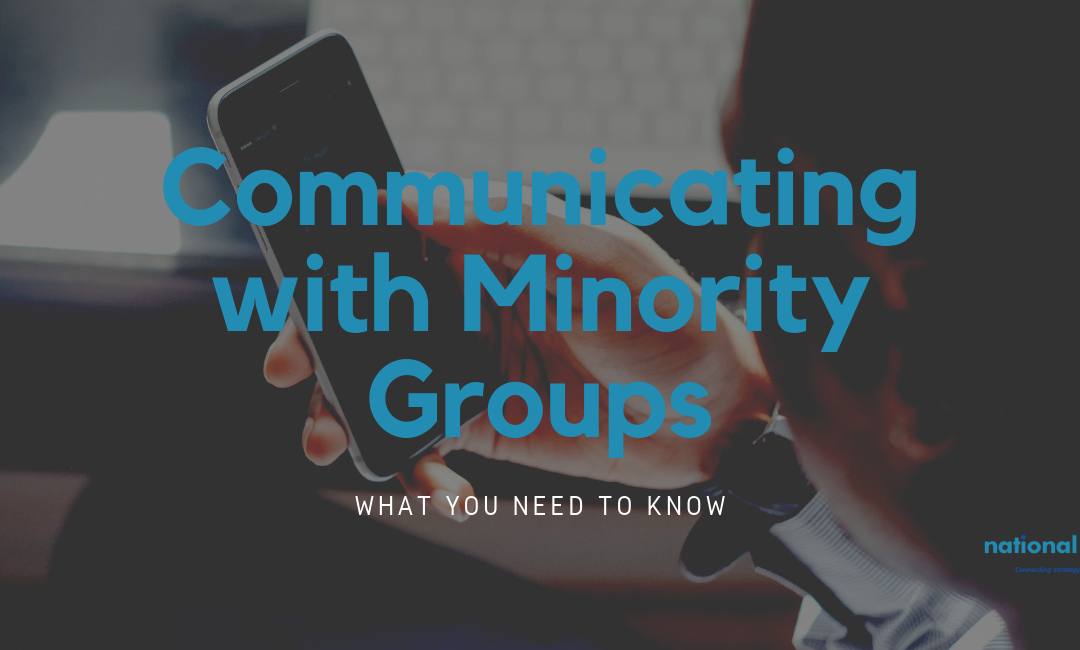
15 Apr Communicating with Minority Groups: What You Need To Know
Communicating with Minority Groups: What You Need To Know The U.S. is one of the greatest melting pots on the planet with one of the most celebrated and diverse populations including different races, religions, ethnicities, cultures, and languages.
According to the most recent United States Census, there are five racial categories officially recognized (White American, Black or African American, Native American and Alaska Native, Asian American, and Native Hawaiian and Other Pacific Islander) as well as people of two or more races.[2][3][4] The Census Bureau also classified respondents as “Hispanic or Latino” or “Not Hispanic or Latino”, identifying Hispanic and Latino as an ethnicity (not a race), which comprises the largest minority group in the nation, according to Wikipedia.
African Americans are the largest racial minority, comprising an estimated 12.7% of the population. Hispanic and Latino Americans are the largest ethnic minority, comprising an estimated 17.8% of the population, according to Wikipedia.
These reports show exciting trends and new diversity being expanded in our growing nation. This means it’s more important than ever to communicate with minority populations and understand what is important to them to be able to effectively grow your organization.
One place to draw inspiration for diversity is in New York City where we have businesses serving very specific and diverse populations. One oncology practice shares with us how their incoming call message speaks five languages using authentic speakers and accents for patients to choose from. They cater to and understand referring physicians and patient groups coming from specific populations and capitalize on meeting their language, cultural, and ethical needs.
So, how can your organization communicate in greater reach to minority populations? Check out our tips here:
1. Understand the populations in your market. Really get to know the statistics and then the characteristics of who is living in the community you’re aiming to serve. Our HQ is located in an area with a rich Hispanic and Latino population. We have a high percentage of this group and it’s celebrated in our community with billboards in Spanish, coveted restaurants, and organizations specializing in this community.
But within the Hispanic and Latino population, there are subpopulations. Some residents might have Cuban backgrounds where other families are from Puerto Rico. They should be treated differently as they are indeed, different! Make sure your business isn’t over-categorizing each population and truly understands the cultures involved. There could be a word in Spanish that has a totally different meaning to each subpopulation, for example. We’ve seen instances where one message is received well by one subpopulation and actually disliked by another. Dive into the information and your organization will thrive in results.
2. Communications should reflect the minority’s culture more than anything else. Your business might have a certain message that you want to get out, however, what might be important for you, may not be for various diverse populations. Truly understanding what is important to each minority group will be an important first step in communicating. Be certain to find out why it’s important to them to understand their perspective in greater depth. For example, simply putting a post on social media in a different language probably will have little effect if you don’t include imagery and messaging that would be important to the population you’re aiming to reach.
3. Celebrate important holidays and observances for minority groups. This point sounds simple enough, but it can be complex. Your message of celebration needs to be respective to the minority population’s culture. Posting a graphic on social media or a billboard stating how your organization is honoring a certain holiday won’t be enough. Aim to understand the details of such important dates and holidays and carve out your messaging to reflect such.
4. Get involved with the community. There’s nothing like saying you’re helping diverse markets than actually rolling up your sleeves and getting involved. Not only should your organization employ individuals from minority groups, but representatives of your establishment should be involved with cultural chambers and networks to truly make and understand the difference. Your organization should show authenticity by getting involved in the community with real representation.
5. Get your stories heard to the appropriate media outlets. There is almost guaranteed a newspaper or some type of news outlet for any and every subpopulation in nearly every area. Get to know these outlets and share your appropriate stories with them. By appropriate we mean, is it interesting to them, their audience, and does it make a difference to their readership/viewership in some way. Don’t ‘blanket share’ your company news with targeted outlets because they really are there to report on their specific audience’ interest.
Whether your business is a health care practice respecting a certain religious population or a retail establishment aiming to attract customers of a specific population, there are lots of ways to observe, respect and effectively communicate with minority populations to make a difference.
For help establishing a plan to communicate with specific markets, give us a call at (813) 865-3093.


Sorry, the comment form is closed at this time.